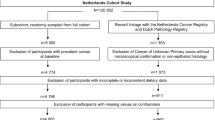Abstract
The role of fruit and vegetables in breast cancer (BC) development has long been debated. A large variety of vegetables and fruit are consumed by Mediterranean populations, a favourable setting for evaluating the effects of these foods. The association between vegetables and fruit consumption, overall and by specific types, and BC risk was studied in the Italian section of the European Prospective Investigation into Cancer and Nutrition study. Over 31,000 women, aged 36-64 years, recruited in five Italian centers between 1993 and 1998, were available for analyses with dietary and lifestyle information and anthropometric measurements. After a median follow-up of 11.25 years, 1,072 invasive and in situ incident BC cases were identified. Cox proportional hazard models (adjusted for education, anthropometry, reproductive history, hormone replacement therapy, physical activity, alcohol consumption and smoking habits) showed an inverse association between consumption of all vegetables and BC risk (highest vs. lowest quintile HR 0.65; 95% CI 0.53–0.81, P for trend = 0.003). According to subtypes of vegetables, an inverse association emerged for increasing consumption of leafy vegetables (highest vs. lowest quintile HR 0.70; 95% CI 0.57–0.86, P for trend = 0.0001) and fruiting vegetables (highest vs. lowest quintile HR 0.75; 95% CI 0.60–0.94, P for trend = 0.01). An inverse association also emerged with increasing consumption of raw tomatoes (P for trend = 0.03). In contrast, no association of fruit, overall or by subtypes, with BC risk was found. In this Mediterranean population, a clear protective role of increasing vegetables consumption, mainly leafy and fruiting vegetables, on BC risk emerged.
Similar content being viewed by others
References
World Cancer Research Fund/American Institute for Cancer Research (2007) Food, nutrition and the prevention of cancer: a global perspective. AICR, Washington
Gandini S, Merzenich H, Robertson C, Boyle P (2000) Meta-analysis of studies on breast cancer risk and diet: the role of fruit and vegetable consumption and the intake of associated micronutrients. Eur J Cancer 36:636–646
Smith-Warner SA, Spiegelman D, Yaun SS et al (2001) Intake of fruits and vegetables and risk of breast cancer: a pooled analysis of cohort studies. JAMA 285:769–776
Riboli E, Norat T (2003) Epidemiologic evidence of the protective effect of fruit and vegetables on cancer risk. Am J Clin Nutr 78(Suppl 3):559S–569S
van Gils CH, Peeters PH, Bueno-de-Mesquita HB et al (2005) Consumption of vegetables and fruits and risk of breast cancer. JAMA 293:183–193
Franceschi S, Favero A, La Vecchia C et al (1995) Influence of food groups and food diversity on breast cancer risk in Italy. Int J Cancer 63:785–789
Trichopoulou A, Katsouyanni K, Stuver S et al (1995) Consumption of olive oil and specific food groups in relation to breast cancer risk in Greece. J Natl Cancer Inst 87:110–116
Landa MC, Frago N, Tres A (1994) Diet and the risk of breast cancer in Spain. Eur J Cancer Prev 3:313–320
Sieri S, Krogh V, Pala V et al (2004) Dietary patterns and risk of breast cancer in the ORDET cohort. Cancer Epidemiol Biomarkers Prev 13:567–572
Palli D, Berrino F, Vineis P et al (2003) EPIC-Italy. A molecular epidemiology project on diet and cancer: the EPIC-Italy Prospective Study. Design and baseline characteristics of participants. Tumori 89:586–593
Pisani P, Faggiano F, Krogh V, Palli D, Vineis P, Berrino F (1997) Relative validity and reproducibility of a food-frequency dietary questionnaire for use in the Italian EPIC centers. Int J Epidemiol 26(Suppl 1):S152–S160
Pala V, Sieri S, Palli D et al (2003) Diet in the Italian EPIC cohorts: presentation of data and methodological issues. Tumori 89:594–607
Panico S, Dello Iacovo R, Celentano E et al (1992) Progetto ATENA, a study on the etiology of major chronic diseases in women: design, rationale and objectives. Eur J Epidemiol 8:601–608
Smith-Warner SA, Spiegelman D, Ritz J et al (2006) Methods for pooling results of epidemiologic studies: the pooling project of prospective studies of diet and cancer. Am J Epidemiol 163:1053–1064
DerSimonian R, Laird N (1986) Meta-analysis in clinical trials. Control Clin Trials 7:177–188
Higgins JP, Thompson SG (2002) Quantifying heterogeneity in a meta-analysis. Stat Med 21:1539–1558
Key T (2010) Fruit and vegetables and cancer risk. Br J Cancer 104:6–11
Masala G, Ambrogetti D, Assedi M, Giorgi D, Rosselli del Turco M, Palli D (2006) Dietary and lifestyle determinants of mammographic breast density. A longitudinal study in a Mediterranean population. Int J Cancer 118:1782–1789
Terry P, Wolk A, Persson I, Magnusson C (2001) Brassica vegetables and breast cancer risk. JAMA 285:2975–2977
Malin AS, Qi D, Shu XO et al (2003) Intake of fruits, vegetables, and selected micronutrients in relation to the risk of breast cancer. Int J Cancer 105:413–418
Zhang CX, Ho SC, Chen YM, Fu JH, Cheng SZ, Lin FY (2009) Greater vegetable and fruit intake is associated with a lower risk of breast cancer among Chinese women. Int J Cancer 125:181–188
Boggs DA, Palmer JR, Wise LA et al (2010) Fruit and vegetables intake in relation to risk of breast cancer in the Black Women’s Health Study. Am J Epidemiol 172:1268–1279
Ambrosone CB, McCann SE, Freudenheim JL, Marshall JR, Zhang Y, Shields PG (2004) Breast cancer risk in premenopausal women is inversely associated with consumption of broccoli, a source of isothiocyanates, but is not modified by GST genotype. J Nutr 134:1134–1138
Ribaya-Mercado JD, Blumberg JB (2004) Lutein and zeaxanthin and their potential roles in disease prevention. J Am Coll Nutr 23:567S–587S
Acknowledgments:
We wish to thank all EPIC Italy participants. The EPIC Italy collaboration has been supported by the Associazione Italiana per la Ricerca sul Cancro (AIRC Milan) and Programma Integrato Oncologia (PIO-Regione Toscana, Ministero della Salute, Rome, Italy).
Conflict of interest
None of the authors had any personal or financial conflicts of interest.
Author information
Authors and Affiliations
Corresponding author
Rights and permissions
About this article
Cite this article
Masala, G., Assedi, M., Bendinelli, B. et al. Fruit and vegetables consumption and breast cancer risk: the EPIC Italy study. Breast Cancer Res Treat 132, 1127–1136 (2012). https://doi.org/10.1007/s10549-011-1939-7
Received:
Accepted:
Published:
Issue Date:
DOI: https://doi.org/10.1007/s10549-011-1939-7




